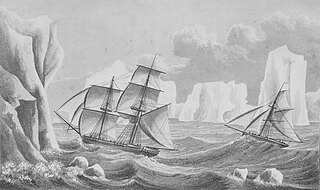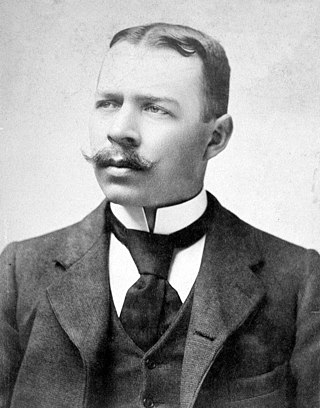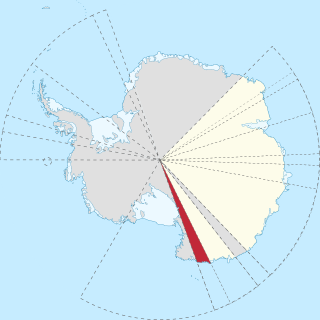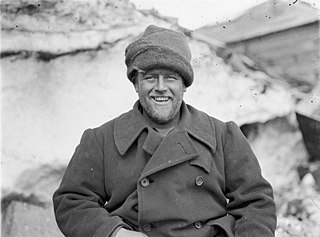Related Research Articles

The history of Antarctica emerges from early Western theories of a vast continent, known as Terra Australis, believed to exist in the far south of the globe. The term Antarctic, referring to the opposite of the Arctic Circle, was coined by Marinus of Tyre in the 2nd century AD.

Sir Douglas Mawson was a British-born Australian geologist, Antarctic explorer, and academic. Along with Roald Amundsen, Robert Falcon Scott, and Sir Ernest Shackleton, he was a key expedition leader during the Heroic Age of Antarctic Exploration.

James Francis "Frank" Hurley was an Australian photographer and adventurer. He participated in a number of expeditions to Antarctica and served as an official photographer with Australian forces during both world wars. He was the official photographer for the Australasian Antarctic Expedition and the Imperial Trans-Antarctic Expedition of 1914–16.

Carsten Egeberg Borchgrevink was a Norwegian polar explorer and a pioneer of Antarctic travel. He inspired Sir Robert Falcon Scott, Sir Ernest Shackleton, Roald Amundsen, and others associated with the Heroic Age of Antarctic Exploration.
The Australian National Antarctic Research Expeditions is the historical name for the Australian Antarctic Program (AAP) administered for Australia by the Australian Antarctic Division (AAD).

The British Australian (and) New Zealand Antarctic Research Expedition (BANZARE) was a research expedition into Antarctica between 1929 and 1931, involving two voyages over consecutive Austral summers. It was a British Commonwealth initiative, driven more by geopolitics than science, and funded by the United Kingdom, Australia and New Zealand.

Mawson's Huts are a collection of buildings located at Cape Denison, in the far eastern sector of the Australian Antarctic Territory, some 3000 km south of Hobart. The huts were erected and occupied by members of the Australasian Antarctic Expedition (AAE) of 1911–1914, led by geologist and explorer Sir Douglas Mawson.

Oates Land is a region of Antarctica. It is variously defined as a portion of the East Antarctica near the coast stretching along and inland from the Oates Coast and as an officially delineated wedge-shaped segment of the Australian Antarctic Territory. The segment of the Australian claim extends between 153°45' E and 160° E, forming a wedge between Latitude 60° S and the South Pole. It is bounded in the east by the Ross Dependency and overlaps George V Land to the west.

Multiple governments have set up permanent research stations in Antarctica and these bases are widely distributed. Unlike the drifting ice stations set up in the Arctic, the current research stations of the Antarctic are constructed either on rocks or on ice that are fixed in place.
Phillip Garth Law, AC, CBE, FAA, FTSE was an Australian scientist and explorer who served as director of Australian National Antarctic Research Expeditions (ANARE) from 1949 to 1966.
The Soviet Antarctic Expedition was part of the Arctic and Antarctic Research Institute of the Soviet Committee on Antarctic Research of the Academy of Sciences of the USSR. It was succeeded by the Russian Antarctic Expedition.

The Heroic Age of Antarctic Exploration was an era in the exploration of the continent of Antarctica which began at the end of the 19th century, and ended after the First World War; the Shackleton–Rowett Expedition of 1921–1922 is often cited by historians as the dividing line between the "Heroic" and "Mechanical" ages.

Wilkes Station was an Antarctic research station established 29 January 1957 by the United States as one of seven U.S. stations established for the International Geophysical Year (IGY) program in Antarctica. It was taken over by Australia on 7 February 1959.

Isaac "Ike" Schlossbach was an American polar explorer, submariner and aviation pioneer.

The Southern CrossExpedition, otherwise known as the British Antarctic Expedition, 1898–1900, was the first British venture of the Heroic Age of Antarctic Exploration, and the forerunner of the more celebrated journeys of Robert Falcon Scott and Ernest Shackleton. The brainchild of the Anglo-Norwegian explorer Carsten Borchgrevink, it was the first expedition to over-winter on the Antarctic mainland, the first to visit the Great Ice Barrier—later known as the Ross Ice Shelf—since Sir James Clark Ross's groundbreaking expedition of 1839 to 1843, and the first to effect a landing on the Barrier's surface. It also pioneered the use of dogs and sledges in Antarctic travel.

Nobu Shirase was a Japanese army officer and explorer. He led the first Japanese Antarctic Expedition, 1910–12, which reached a southern latitude of 80°5′, and made the first landing on the coast of King Edward VII Land.

Tourism started in Antarctica by the sea in the 1960s. Air overflights started in the 1970s with sightseeing flights by airliners from Australia and New Zealand, and were resumed in the 1990s. The (summer) tour season lasts from November to March. Most of the estimated 14,762 visitors to Antarctica from 1999–2000 were on sea cruises. During the 2009 to 2010 tourist season, over 37,000 people visited Antarctica.

Walter Henry Hannam (1885–1965) was an Australian wireless experimenter, a founding member of the Wireless Institute of Australia, wireless operator and mechanic on the Australasian Antarctic Expedition, a member of the ANZAC Wireless Company in World War I, and tireless promoter of amateur radio in the 1920s.

The Antarctic gateway cities are five cities on the rim of the Southern Ocean through which nearly all cargo and personnel bound for Antarctica pass. From west to east, they are Punta Arenas, Chile; Ushuaia, Argentina; Cape Town, South Africa; Hobart, Australia; and Christchurch, New Zealand. As Antarctica is a low-resource environment with no major transportation infrastructure of its own, gateway cities are a necessary part of all Antarctic activities.
References
- ↑ Antarctic Pioneers at National Film and Sound Archive
- ↑ "AUSTRALIA'S ROLE IN THE ANTARCTIC". The Canberra Times . Vol. 37, no. 10, 527. Australian Capital Territory, Australia. 4 May 1963. p. 18. Retrieved 19 January 2017– via National Library of Australia.